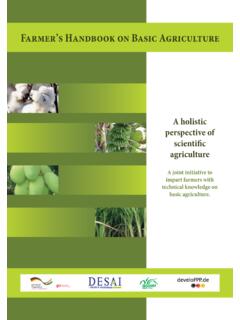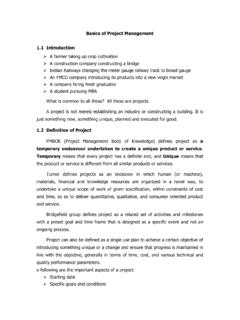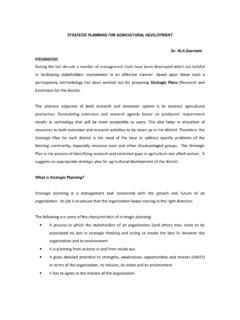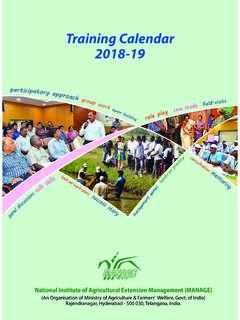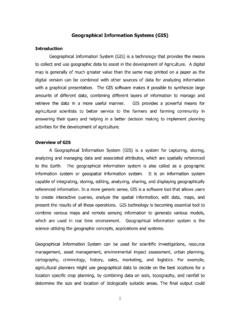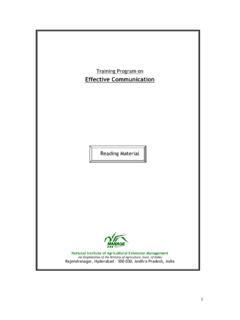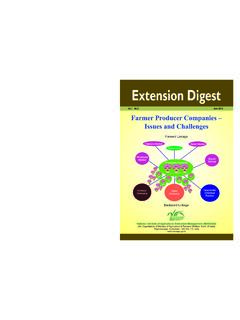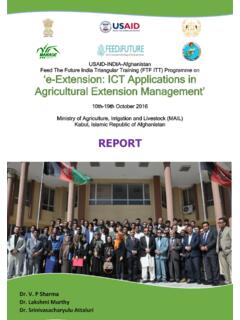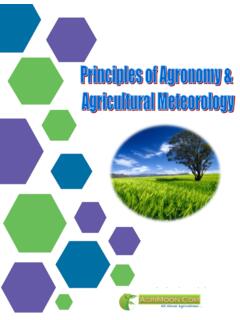Transcription of FARMING SYSTEMS APPROACH Introduction
1 FARMING SYSTEMS APPROACH Dr. M. A. Kareem Introduction Public sector extension in India has undergone several transformations since independence in 1947. Initially, the focus of extension was on human and community development, but during the remainder of the 20th Century there was a steady progression toward technology transfer within the policy framework of food security. The most significant development during the mid-seventies was the Introduction of the Training and Visit (T&V) Extension management system. By the 1990s, the Indian Extension system was at a crossroads. Since Extension had focused on disseminating Green Revolution technology for the major cereal crops for the past two decades, extension activities were largely carried out by state Departments of Agriculture (DOA). Other line departments, like Animal Husbandry (DAH), Horticulture (DOH) and Fisheries (DOF), had very limited extension capacity and primarily focused on the provision of subsidized inputs and services to farmers.
2 In addition, these line departments operated largely independently, with very little collaboration between the departments and their field staff. In the late-1990s, the Government of India (GOI) and the World Bank pilot-tested a new, decentralized, market-driven extension model under the National Agricultural Technology Project (NATP). This new APPROACH was designed to help farmers diversify into high-value crops and livestock enterprises as a means of increasing farm incomes and rural employment ( poverty alleviation). The key institution in implementing this new APPROACH was the Agricultural Technology Management Agency (ATMA), which was to facilitate and coordinate farmer-led extension activities within each district. The key elements of the ATMA model included: 1) organizing small-scale farmers, including women, into farmer interest groups (FIGs), 2) linking these groups to markets, 3) decentralizing extension decision-making down to the district and block levels; 4) taking a more FARMING SYSTEMS APPROACH , requiring the integration of extension activities across the different line departments.
3 Now let us understand the FARMING system APPROACH (FSA) through concept and definitions. Concept FARMING system is an integrated set of activities that farmers perform in their farms under their resources and circumstances to maximize the productivity and net farm income on a sustainable basis. The FARMING system takes into account the components of soil, water, crops, livestock, labour, capital, energy and other resources, with the farm family at the centre managing agriculture and related activities. The FARMING system conceptually is a set of elements or components that are interrelated which interact among themselves. At the center of the interaction is the farmer exercising control and choice regarding the types of results of interaction. The income from cropping alone from small and marginal farm is insufficient now to sustain the farmers family. A judicious mix of any one or more of these enterprises with agronomic crops.
4 Should complement the farm income and help in recycling the farm residues / wastes. The selection of enterprises must be based on the cardinal principles of minimizing the competition and maximizing the complementary between the enterprises. Of late, the researchers on multi disciplinary APPROACH greatly realized and started developing the various FARMING SYSTEMS models in accordance with the agro -eco SYSTEMS zones . Since 1978, both scientists, extensionists, anthropologists, social workers, administrators have been publishing many articles on FSRE in different journals. Simmonds in 1984 clarifies the FARMING System APPROACH as follows: It is an academic activity comprising of theory, concepts, principles, approaches etc. It creates an opportunity for developing diversified models for different type of farmers and different category of farmers. New FARMING system APPROACH models could be developed by means of on farm research and extension.
5 It causes consequential a complex change which demands for Government interventions for FARMING SYSTEMS development BIGGS (1985) explained the concept of FSA as follows: it is a problem solving APPROACH for the farmer. FARMING system APPROACH requires commonly homogenous type of farmers. It is an inter-disciplinary APPROACH . It is a participatory and bottom up planning. It requires on farm trials. It depends on the concept learning by doing and FARMING system APPROACH needs socially desirable technologies. Thus the concept of FARMING System APPROACH can be summarized as it is a holistic APPROACH , complex in nature, interrelated of components, matrix of soils, plants, animals, power, implements, labour, capital and other inputs, influenced by political, economic, institutional and social forces. Definitions FARMING SYSTEMS APPROACH relates to the whole farm rather than individual elements; it is driven as much by the overall welfare of FARMING households as by goals of yield and profitability.
6 FARMING SYSTEMS are closely linked to livelihoods because agriculture remains the single most important component of most rural people s living and also plays an important role in the lives of many people in semi-urban areas. FARMING SYSTEMS involve a complex combination of inputs, managed by FARMING families but influenced by environmental, political, economic, institutional and social factors. Research and extension institutions are increasingly aware that a holistic APPROACH , drawing on both local and external knowledge, is necessary if they are to be effective in addressing poverty and sustainability. FARMING System is defined as a complex inter related matrix of soil, plants, animals, implements, power, labour capital and other inputs controlled in part by FARMING families and influenced to varying degrees by political, economic, institutional and social forces that operate at many levels. The FARMING system therefore, refers to the farm as an entity of inter dependent FARMING enterprises carried out on the farm.
7 The farm is viewed in a holistic manner. The farmers are subjected to many socio-economic; biophysical, institutional, administrative and technological constraints. Need for FARMING System APPROACH The need for FARMING SYSTEMS APPROACH in the present scenario is mainly due to high cost of farm inputs, fluctuation in the market price of farm produce, risk in crop harvest due to climatic vagaries and biotic factors. Environmental degradation, depletion in soil fertility & productivity, unstable income of the farmer, fragmentation of holdings and low standard of living add to the intensity of the problem. What it is and What it does It is an APPROACH for developing farm-household SYSTEMS , built on the principles of productivity, profitability, stability and sustainability. All the components are complimentary and supplementary to each other. And the development process involves the participation of rural communities. The FARMING system APPROACH emphasizes understanding of farm household, community inter linkages, reviews constraints and assesses potentials.
8 And it combines improvements desired from better technology. It needs efficient support services and requires better policies. It is continuous, dynamic and interactive learning process based on analysis, planning, testing, monitoring and evaluation. Why FARMING SYSTEMS APPROACH To develop farm house hold SYSTEMS and rural communities on a sustainable basis To improve efficiency in farm production To raise farm and family income To increase welfare of farm families and satisfy basic needs. An intensive integrated FARMING system addresses two issues, reduction in risk with the monoculture activities and promoting enterprise diversification, value addition and development of alternative income sources with efficient utilization of farm resources. And it brings about enterprise diversification for sustainability and additional benefits, better management of important farm resources like land, labor and capital etc. Provides an opportunity for effective recycling of the product and by-products, helps to generate flow of cash to the farmers round the year by way of disposal of milk, fruits, fuel, manure etc.
9 , beside other agricultural output. FARMING SYSTEMS Strategy In view of serious limitations on horizontal expansion of land and agriculture, only alternative left is for vertical expansion through various farm enterprises required less space and time but giving high productivity and ensuring periodic income specially for the small and marginal farmers located in rainfed areas, dry lands, arid zone, hilly areas, tribal belts and problem soils. The following farm enterprises could be combined: Agriculture alone with different crop combinations Agriculture + Livestock Agriculture + Livestock + poultry Agriculture +Horticulture + Sericulture agro -forestry + Silvipasture Agriculture (Rice) + Fish culture Agriculture (Rice) + Fish + Mushroom cultivation Floriculture + Apiary (beekeeping) Fishery + Duckery + poultry For meaningful execution of integrated farm-enterprises, the following activities should be undertaken by a multi-disciplinary team of extension professionals with farmer s participation and involvement at all stages.
10 Thorough understanding of existing FARMING SYSTEMS and their components Assessment of resource availability in the farm environment and identification of bio-physical, socio-economic, institutional, administrative and technological constraints Developments of economic viable and efficient integrated FARMING SYSTEMS suitable for various domains Diffusion of improved technology and receiving feed back for further improvement of the system as a whole. Continuous improvement in components technology to fit into a given FARMING system Improvement in quality of FARMING system Research Extension linkage through On farm Adaptive Research Development of National and International linkages Methodology adopted for grounding the concept of FSA I. Identification of major socio-economic situations Understanding dominant enterprises and most common existing FARMING system Analysis of economic viability of existing FARMING SYSTEMS Understanding relationship between different enterprises Analysis of linkages between different FARMING SYSTEMS II.
